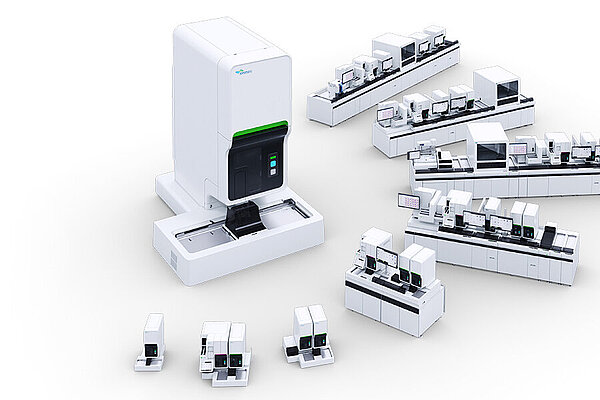Everything to keep patients safe
XTRA-ARTIKEL AUSGABE 2/2019
A higher demand for blood products, fewer donors and an increased risk from infected donations: transfusion medicine operates in a tense atmosphere in which the right laboratory analysis can help.
Text: Verena Fischer
The European Patient Blood Management (PBM) Network was founded back in May 2016 during the annual meeting of the European Society of Anaesthesiology. Apart from the health risks associated with blood transfusions, the primary objective is to prevent a global shortage of blood. The World Health Organisation (WHO) has warned that demographic change may cause supply bottlenecks, because 42 percent of the around 117 million global blood donations every year are from industrialised countries with senescent social structures.
Whereas around half of the blood that is donated in poorer countries is used for infants, in the more affluent regions it is the over 65s who receive three quarters of all transfusions. This means that while the number of recipients is rising, donor availability is falling. Europe often experiences bottlenecks during the summer months because experience has shown that the willingness to donate blood falls with rising temperatures.
Red blood cell preparations are the most in-demand blood products in hospitals, while the supply of blood plasma, which can be donated separately at a comparably high frequency (up to 45 times a year in Europe), is almost as important. Plasma is used in transfusions and is required for the production of life-saving medications to treat blood coagulation disorders. Europe satisfies its demand for plasma largely with US imports. The problem here is that the donors sometimes receive a lot of money for this, something that can lower the quality. This is because commercial blood is more likely to contain communicable pathogens, according to the WHO.

Challenge: globalisation
The risk of contracting an infection from blood products is currently low. To make sure that this remains so, a larger number of pathogens is to be ruled out in future through analyses in the donor qualification laboratory. The risk of an infection with a tropical disease through a transfusion is growing on the account of global warming and the trend for long-distance travel. Pathogens are encountering their vectors (exotic species of mosquitoes) ever more frequently in this part of the world. It remains to be seen how long a questionnaire on travel behaviour will be adequate as the only instrument to rule out this kind of infection.
Laboratory analyses, on the other hand, can reliably guarantee the quality of blood products. Globalisation is challenging transfusion doctors in many ways: the biggest possible diversity of donors is essential so as to be able to offer the right blood products for people from different countries of origin. The exclusion of tropical diseases through laboratory analyses can also help facilitate a qualification of immigrants at short notice. For example, with the Sysmex XN-31 analysis system, which can detect and count red blood cells that are infected with malaria with a high sensitivity and specificity in just one minute.
Patient blood management
These developments clearly show that a Europe-wide introduction of patient blood management is an important step. The multi-dimensional concept helps improve patient care and safety by strengthening endogenous blood supplies so as to improve the handling of blood products and minimise the transfusion risks. An increasing number of hospitals are following this call and are implementing the concept. The goal of the PBM network is to prepare patients in the best possible way for surgery and to reduce perioperative blood losses. To this end, a check is made for anaemia in the run-up to all major, scheduled operations. Anaemia during an operation is a major risk factor for a higher hospital mortality rate and other complications. Studies show that the short-term treatment of anaemia or iron deficiency, for example preceding heart surgery, can lower the transfusion rate. This vindicates the widespread introduction of patient blood management and proves its efficacy.
Patient blood management improves the handling of blood products and strengthens endogenous blood supplies
Blood losses during or after an operation as well as the taking of blood samples during hospitalisation can place a further strain on the body’s blood supplies. This is often compensated directly by using allogenic blood reserves. This is why it is important to clarify any anaemia beforehand through a differential diagnosis and treat this before surgery wherever possible. Apart from chronic illnesses such as inflammations, tumours, autoimmune diseases or renal insufficiency, the cause in around one third of patients is iron deficiency. Treating anaemia in someone with a chronic illness often poses problems, whereas it is relatively easy to correct an iron deficiency. The systems of the XN and XN-L Series from Sysmex offer the possibility of supporting anaemia management quickly, cheaply and effectively. The RET-He, Hypo-He and Delta-He parameters from the RET channel may play a key role here to tailor the iron therapy to the respective patient and monitor the success.
The second pillar on which physicians rely is keeping the blood losses during surgery as low as possible. This can be facilitated by keyhole methods as well as optimum coagulation management. A precise and consistent check of the physiological conditions (such as body temperature, ionised calcium, pH value) helps too. If large amounts (> 500 millilitres) of blood are lost, mechanical autotransfusion – in other words the collection, cleaning and return of blood from wounds – is a valuable option to minimise the use of allogenic blood products. Reduced volumes in the blood collection tubes as well as a deliberate sampling frequency are also indicated.
The third possibility is aimed at the rational use of red blood cell concentrates. Whether a transfusion is necessary depends not only on the haemoglobin level. The patient’s clinical condition also plays a role here: individual anaemia tolerance and physiological transfusion triggers, such as a drop in the central venous O2 saturation to below 60 percent. Allogenic blood transfusion should be the final option so as to spare patients possible risks.
Summary:
- Falling numbers of blood donors and increasing numbers of recipients lead to supply bottlenecks.
- This is accompanied by a simultaneous increase in the risks associated with blood transfusions.
- A dedicated patient blood management system and the focused use of laboratory analyses are needed here.
Image source: Shutterstock

